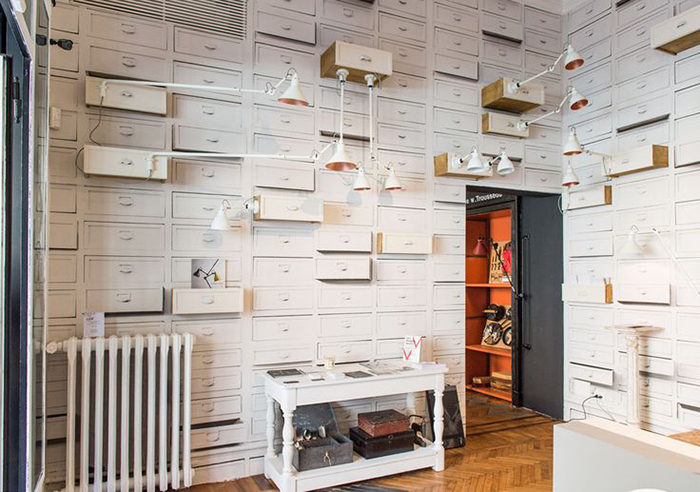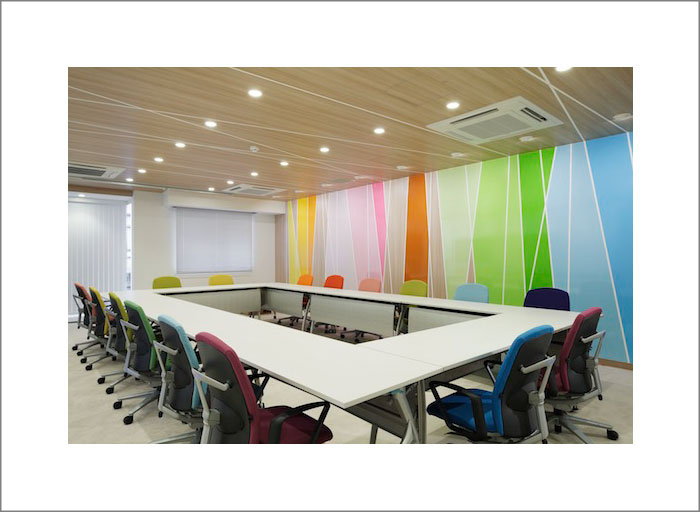 Design firm Cabinet Braun-Braën created a warm and intimate restaurant environment by applying texture using a brick wall finish.
Design firm Cabinet Braun-Braën created a warm and intimate restaurant environment by applying texture using a brick wall finish.
Before we talk about texture and how it can affect an interior space, let’s quickly debrief on the term “elements of design”. To create visually appealing spaces, interior designers apply various elements of design – line and shape, colour, texture & pattern, proportion, and light. In recent posts we discussed how lines and colour could be applied in commercial interiors to communicate a corporate message through a built environment, today let’s focus on texture and pattern.
Texture
 Texture reigns in this project for Lampe Gras fitting by Raw for the Fuorisalone 2014,. I bet you wouldn’t have guessed that a lot of this texture was created using the “In Mind” wallcovering from Wall and Deco!
Texture reigns in this project for Lampe Gras fitting by Raw for the Fuorisalone 2014,. I bet you wouldn’t have guessed that a lot of this texture was created using the “In Mind” wallcovering from Wall and Deco!
When an interior designer refers to texture they are speaking to the surface quality of a material. Every surface has a texture whether it be smooth or rough, bumpy or flat. Our perception of texture is also influenced by the textures of adjacent surfaces, our viewing distance, as well as the lighting applied. For example, rough surfaces seem more textured next to smooth surfaces, when viewed up close, and when grazed with light (i.e. lit from the side).
Additionally, texture can be described as either tactile or visual. Tactile texture relates to the actual feeling of a surface – smooth, rough, soft, hard, etc. Visual texture is our perception of what a texture might feel like. In other words, we often make assumptions about the texture of a material based on our memory of touching similar surfaces.
At Hatch Interior Design, we often incorporate texture to enforce the design concept. As discussed, texture helps to differentiate various objects and surfaces, transform light, and influence scale, but it can also communicate a particular design style. For example, typically when you envision a modern interior, glossy materials and minimally textured surfaces come to mind. These types of surfaces communicate a sleek and simple design style that often relates to contemporary interiors.
Pattern
 See how this colourful pattern really adds interest to this boardroom designed by Emmanuelle Moureaux Architecture and Design?
See how this colourful pattern really adds interest to this boardroom designed by Emmanuelle Moureaux Architecture and Design?
Although pattern can help to add texture to a space it has a very different definition. Pattern relates to the repetition of a graphic motif on a material. Remember that texture refers to the 2D quality of a surface, where as a pattern relates to illustrative perception.
In commercial interior design, pattern is often applied using wallcoverings, tile, carpeting, and other graphic elements. Like texture, pattern can also define surfaces, impact scale, convey a design style, and add visual interest to a space. Be careful when applying pattern; if it’s not well balanced it can really overwhelm an interior environment.
As mentioned, texture and pattern have a huge role in defining the design style of a space. This is why in commercial interior design, it is very important that these elements are applied in a way that relate to the corporate brand of the business. Send the right message to your customers by applying the various elements of design in and effective way.
Did you miss our post about line? Read about it by clicking here.
Did you miss our post about colour? Read about it by clicking here.
